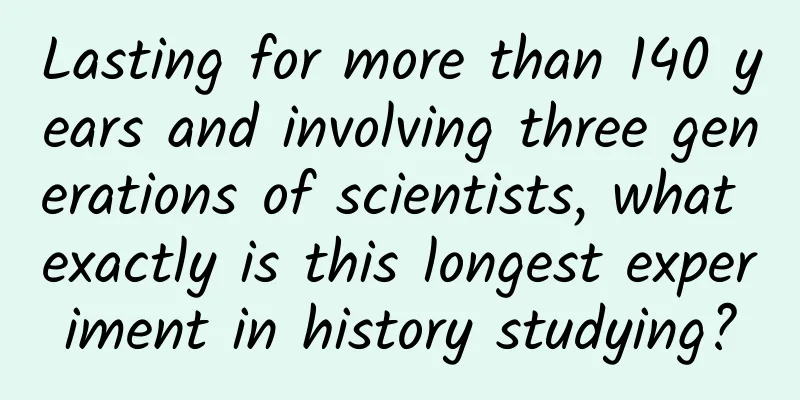Lasting for more than 140 years and involving three generations of scientists, what exactly is this longest experiment in history studying?

|
Seeds are everywhere in our daily lives, from peanuts to coffee beans. But seeds are not just a delicacy on our tables, in botany, they represent the starting point of life. A seed is a package of hope for the future: the seed coat provides protection, the embryo is the origin of life, and the endosperm is full of nutrients. But do you know how strong the vitality of a seed is? How long can it survive? However, before reading this article, no one would dare to believe that the longest record of a seed surviving is 32,000 years! Source of various seed images: Generated by the author AI 32,000-year-old seeds revived in permafrost Imagine that the nut-hunting squirrel in the animated film "Ice Age" probably never imagined that the seeds buried by its ancient counterparts would become a scientific wonder 32,000 years later. In 2007, Russian paleontologists discovered a series of ancient squirrel nests deep in the permafrost of the Kolyma River in Siberia. These caves, 20 to 40 meters underground, became time capsules, preserving a collection of plant seeds about 32,000 years old. In 2012, scientists launched an unprecedented attempt to revive these ancient seeds. They successfully cultivated Silenestenophylla, which was not only a major breakthrough in the history of botany, but also set a new record for the oldest plant seed revival. But this resurrection process is not a simple planting, but a technical challenge. Scientists first extracted embryonic tissue from these ancient seeds, and then used sophisticated tissue culture technology to achieve this restart of life. So how did these seeds, which were buried for 32,000 years, survive to this day? Researchers speculate that after being buried by squirrels, these seeds were frozen in the permafrost, which has not melted since then. This frozen environment provides a unique preservation condition for the seeds, allowing them to travel through time. When these 32,000-year-old plant seeds were discovered and revived by a professional scientific research team, they not only showed relics of the past, but also provided us with a unique opportunity to study ancient organisms. After cultivation, these ancient narrow-leaved flyweeds bloomed flowers. Although the petal spacing, length and leaf shape are slightly different from modern similar plants, their essential characteristics remain unchanged, becoming a biological bridge connecting the past and the present. Image of angustifolia grown from seeds 32,000 years ago: Reference 1 A 2,000-year-old seed miracle in the rubble of an ancient castle Before the angustifolia seeds set a new record for the resurrection of ancient seeds, a story had already been circulating in the scientific community: the resurrection of date palm seeds from 2,000 years ago. This story began in the Arava Desert in southern Israel, a place where date palms once grew. These trees gradually disappeared for hundreds of years due to climate change and lack of water. However, 40 years ago, while excavating the ancient fortress of Masada on the eastern shore of the Dead Sea, archaeologists discovered a batch of date pits, which made the long-lost date palm trees revitalized in modern times. Scientists conducted a series of elaborate experiments with these ancient date pits. They placed the pits in a thermos, slowly poured water, and used gibberellic acid and plant growth hormones to promote their germination and rooting. The seeds were then planted in pots filled with fresh soil. After 26 months of careful cultivation, these date palm seeds that had been dormant for two thousand years not only sprouted, but also grew to a height of 121 cm. This revival was possible due to the extremely dry and hot climate conditions in the Dead Sea region, which provide an almost perfect natural preservation environment for the seeds. Through DNA analysis of these ancient date palm leaves, scientists found that although these ancient varieties are more than 50% similar to modern date palms at the genetic level, they still retain unique historical marks. The most surprising thing is that after unremitting efforts, these ancient trees even produced fruits. The first batch of dates harvested weighed an average of about 18 grams each and were described as extremely delicious. This scientific research achievement is not only a victory for science, but also a beautiful story about time and vitality. Although we cannot witness the resurrection of dinosaurs yet, we can already taste dates that are thousands of years old. This is the charm of scientific research. Figure 32 Date palm trees grown from seeds thousands of years ago (A: seeds; B: 15 cm after 3 months of growth; C: 31 cm after 7.5 months of growth; D: 121 cm after 26 months of growth) Image source: Reference 2 To determine seed longevity Scientists conducted an experiment that lasted a hundred years In the quiet early morning of April 2021, a hidden corner of Michigan State University became a gathering place for a group of botanists. Wearing searchlights, holding shovels and measuring tapes, they followed an old map and began an unusual excavation. Their target is not a treasure in the traditional sense, but a batch of seeds that have been buried for 142 years. These are just some ordinary weed seeds. But they are part of a great scientific experiment that has lasted for more than a century. However, this is a very long and great scientific experiment. Until now, this experiment has been going on for more than 140 years and will not end for another 80 years. Figure 4 Schematic diagram of seed mining Image source: AI generated by the author This experiment, designed by Professor William James Beale in 1879, was designed to explore the actual lifespan of dormant seeds. Professor Beale prepared 20 glass bottles, each containing 1,050 seeds from 21 different plants, 50 seeds of each type, mixed with moist sand and buried on campus. Initially, the plan was to dig up the vials every five years to test the viability of the seeds, but over time this interval was extended, from 10 years in the 1920s to 20 years in the 1980s. After more than a century of waiting, most of these seeds have lost their vitality, but surprisingly, the seeds of Verbascumblattaria are still alive. This discovery not only verifies the amazing vitality of seeds, but also provides us with valuable data on seed survival and ecosystem recovery. Seeds were taken out from the 16th bottle of Professor Bill's collection and germinated. Image source: Reference 3 Professor Bill originally designed this experiment to provide a reference for agriculture and to understand the survival cycle of weed seeds in farmland. But over time, the significance of this experiment has surpassed its original purpose and provided us with important insights into long-term seed preservation and ecological environment improvement. This experiment is expected to end in 2100, and there are still 4 glass bottles waiting for scientists to discover. Conclusion These stories about seeds, from their thousand-year resurrection in ancient ice and desert gravel to century-old experiments at Michigan State University, not only demonstrate the enduring power of seeds as the origin of life, but also reveal the subtle interweaving of life and time in nature. These seeds span thousands of years of history, becoming a bridge between us and the past, and an important symbol of scientific exploration and nature conservation. They teach us to respect nature, remind us of our responsibility in maintaining the ecological balance of the earth, and show us the endless wonders of nature waiting for us to explore, understand and protect. References [1]Yashinaetal.Regenerationofwholefertileplantsfrom30,000-y-oldfruittissueburiedinSiberianpermafrost.PNAS.2012,109(10),4008-4013. [2]Sallonetal.Germination,genetics,andgrowthofancientdateseed.Science.2008,320,1464. [3]Flemingetal.The141-yearperiodforDr.Beal'sseedviabilityexperiment:Ahybridsurprise.AmJournalofBot.2023,110:e16250. This article is a work of Science Popularization China-Starry Sky Project Produced by: Science Popularization Department of China Association for Science and Technology Producer|China Science and Technology Press Co., Ltd., Beijing Zhongke Xinghe Culture Media Co., Ltd. Author: Denovo Science Team Review丨Wang Kang, Director of the Science Museum of the National Botanical Garden |
<<: Let me show you some colors! The source of color in the food world
Recommend
Real scene or AI-generated? The sharp eyes of identifying "Virtual Video" are here! The accuracy rate is as high as 93.7%
Today, AI video generation tools are changing ind...
Huawei once again took the first place in the 5G mobile phone market share list, and its accumulated advantages are obvious
The world is accelerating the construction of 5G ...
If a person is infected with three types of bacteria at the same time, can the bacteria become "vampires"?
Author: Duan Yuechu and Huang Xianghong In the Ap...
12.12 is coming, please check out the wedding photography industry’s advertising secrets!
Following the popularity of 11.11, the 12.12 prom...
Summary and comparison of the three major free new media channels for increasing APP downloads!
The ultimate goal of new media for APPs is to dri...
How does the Android market distribute and promote apps?
This article uses some optimization operations pe...
How to build an efficient user growth model
When talking about growth, people always tend to ...
From now on, the best Android phones come from Google
Google is getting serious about hardware. Some ti...
The era of general artificial intelligence technology has arrived. His research results, like the "spark" in "Transformers", give life to machines.
Publisher of this issue: Chen Junbo, founder and ...
When iOS meets OS X: The boundary between mobile phone and computer operating systems is disappearing
With the launch of the new iOS 7, OS X Mavericks, ...
Table tennis skills teaching video 137 episodes video course Baidu cloud download
Table tennis skills teaching video 137 episodes v...
China to launch Einstein probe to explore ever-changing universe
Conceptual image of the Einstein Probe satellite....
Tips for placing Qianchuan ads on Douyin stores
The short video sales model has become a trend, e...
Is operation and promotion difficult? You can't handle these three user attributes
The categories of operations include data operati...









